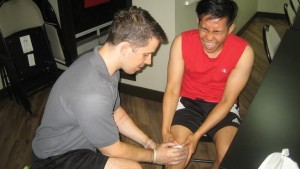Patellar tendinitis is an injury caused on the tendon that attaches the kneecap or patella to the shinbone. The patellar tendon is located at the front of the thigh that functions in extending the knee to help with kicking, jumping and running. Patellar tendinitis is also called jumper’s knee and common in athletes that play sports that require frequent jumping such as volleyball and basketball, but those who do not participate in any jumping sports can also be affected by patellar tendinitis.
Patellar tendinitis is an overuse injury that can be caused by repeated stress on the patellar tendon and this stress will cause small tearing of the tendon which the body tries to repair. As the tearing of the tendon becomes bigger, it will cause inflammation and weakening of the tendons. When the damage on the tendon persists for more than a week, it is called tendinopathy.
Symptoms
- Pain when bending the knee
- Weakness of the leg or calf
Stiffness of the knee when performing jumping, squatting, sitting, kneeling and climbing stairs. - Pain on the patellar tendon especially below the kneecap
- Pain can be felt on the quadriceps muscles
- Stiffness of the knee when performing jumping, squatting, sitting, kneeling and climbing stairs.
- Problems with balance
- Tenderness, warmth or swelling around the lower knee
Treatment
- Take a break from activities that requires running, jumping and squatting.
- Take the prescribed over-the-counter pain medications such as ibuprofen and naproxen sodium helps lessen pain.
- Apply an ice pack after performing any activities that causes pain at least 10 minutes. Place the ice in a plastic bag and wrap with a towel and place on the area that causes pain. Another way is to massage the area using ice. It helps lessen the pain and inflammation.
- Wear a patellar tendon strap which is a band that is wrapped around the leg under the patella and provides pressure on the tendon to minimize the strain on the tendon and lessens the pain. It also helps in supporting the affected area during rehabilitation.
- If experiencing pain when resting the leg, wear a brace in order to help immobilize the leg. Once the pain is minimized while resting, gradually increase the activity as long as it does not cause pain.
- If experiencing severe pain, there is a need to immobilize the leg and seek medical help immediately.
Tips
- If experiencing pain in the knee due to exercise, apply an ice pack on the affected area and take a break.
- Performing unconventional exercises by extending the knee then lowering the knee very slowly. This exercise helps strengthen the muscles and capable of handling stress that can cause patellar tendinitis.
- When starting a new sport or using exercise equipment, take lessons or seek professional instructions in order to help in improving the techniques.

